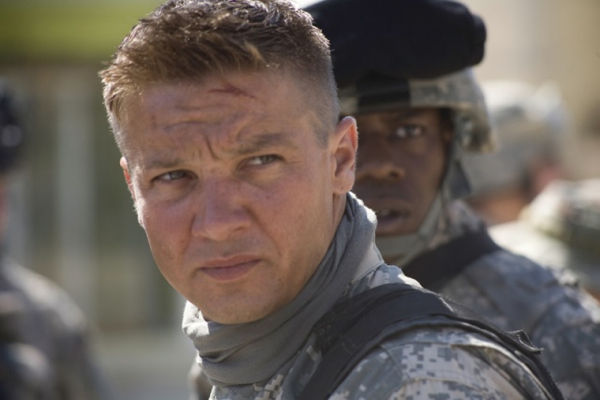Movie review by Greg Carlson
Veteran Hollywood action filmmaker/adrenaline engineer Kathryn Bigelow offers her finest movie to date in “The Hurt Locker,” a brutal and intense tour of duty with a team of American soldiers charged with the ugly, dangerous task of defusing improvised explosive devices in Iraq. Bigelow, whose credits include several films with sturdy cult followings, including the often-overlooked vampire Western “Near Dark” (1987), the bank robber/surfer hit “Point Break” (1991) and the influential cyberpunk mindbender “Strange Days” (1995), continues to demonstrate her facility with stunningly staged, emotionally charged material, but “The Hurt Locker” boasts a level of gritty realism missing from most of the filmmaker’s previous large scale features.
Mark Boal’s screenplay, structured straightforwardly around seven specific set pieces, adroitly balances the pulse-quickening, heart-racing suspense inherent in the bomb squad’s job description with keenly observed, subtly illustrated hints that help explain why a person would pursue one of the most stressful specialties in the military. At the heart of the story is Staff Sergeant William James, played by Jeremy Renner in a breakout performance. Renner, a dependable actor often cast in supporting roles, is marvelous and commanding as James, a deeply troubled professional for whom the daily risk of his life is nothing short of a calling.
James finds a perfect foil in meticulous professional Sergeant JT Sanborn (Anthony Mackie, also excellent), a point man who provides James with cover whenever a bomb call requires the team’s attention. Mackie and Renner invest their characters with a blend of admiration and disgust for one another that speaks to the complexity of a dynamic based upon critical trust and communication. When James recklessly tosses aside his headphones or strips off his hulking Kevlar blast protection suit, Sanborn seethes with dumbfounded frustration and helplessness that contrast sharply with the military’s masculine codes.
For all of its sweaty anxiety, “The Hurt Locker” modifies many of the expectations of combat thrillers. Sustained tension replaces full-throttle depictions of small arms melees, and Bigelow works wonders with the rhythm and pacing of each of the sequences in which James and company find themselves in harm’s way. Even a long distance face-off in which snipers pin down a small group of American soldiers and fire-eating UK contractors is a miniature marvel of spatial dynamics and carefully timed shots. In the sequence, Bigelow suggests the excruciating passage of time without sacrificing any of the nauseating fear that keeps the soldiers on a razor’s edge. Like many of the movie’s scenarios, the desert gunfight has a way of sticking with you long after the film has ended.
“The Hurt Locker” bests nearly all other Iraq war movies in its examination of the psychological effects of armed combat — without resorting to many of the oversimplified explanations movies tend to offer. Instead, several tricky questions are raised that transcend the good-versus-evil dialectic that governs so much of American popular culture. Is James addicted to his impossibly treacherous work? Is he mentally ill? What does it take to be an Explosive Ordnance Disposal technician when the job is so thoroughly perilous? “The Hurt Locker” never gives any definitive answers, and it shouldn’t. To do so would mute its considerable impact.
